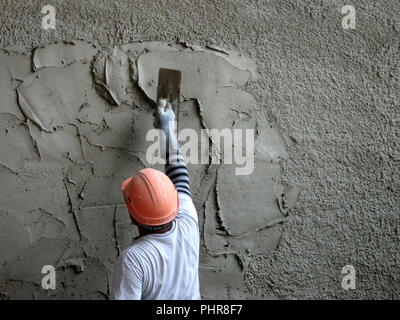Trick Tips and Tools for Successful Gluing in your house Renovation Ventures
Attaining a remarkable plaster coating in your home renovation jobs requires a blend of the right tools and proven strategies. Crucial applies such as the hawk and trowel are important for effective application, while appropriate surface preparation lays the foundation for success. Moreover, recognizing the nuances of mixing plaster and using it in thin layers can dramatically influence the final end result. As we explore these basic aspects, it comes to be apparent that staying clear of usual mistakes can elevate your plastering skills-- guaranteeing your following project not only fulfills yet exceeds assumptions.
Necessary Plastering Devices
The necessary devices encompass a selection of executes created to facilitate the gluing process efficiently and efficiently. Secret parts consist of a hawk, which is a flat, square tool utilized to hold the plaster while using it to surfaces.

Additionally, a blending bucket is essential for preparing plaster, making certain the ideal uniformity prior to application (Plastering). Together, these vital plastering devices allow both experts and DIY lovers to attain high-quality results in their smudging tasks.
Surface Area Prep Work Methods
Effectively preparing the surface before plastering is important for guaranteeing bond and achieving a flawless finish. The very first step includes cleaning the surface to remove any type of dirt, grease, or old paint that may impede the plaster's ability to bond properly. A thorough clean with an appropriate cleaning option is advised, followed by rinsing and enabling the surface area to dry totally.
Following, analyze the surface area for any type of imperfections or splits. These need to be loaded with an ideal filler substance and allowed to treat according to the maker's directions. For permeable surfaces, applying a primer is important to create an uniform appearance and boost adhesion.
In addition, it is vital to ensure that the surface area is stable and structurally audio. Any type of loosened products, such as flaking paint or harmed drywall, need to be fixed or removed. Take into consideration making use of a scratch coat to boost grasp. if functioning with stonework surface areas.
Combining Plaster Like a Pro

Using a tidy blending container, put the water first, after sites that progressively add the plaster powder while mixing constantly - Plastering. This approach assists to stop clumping and ensures an even distribution of materials. A Recommended Reading mechanical mixer can be beneficial, saving and supplying consistent outcomes time. Goal for a luscious, lump-free consistency that allows for very easy spreading however is thick sufficient to hold its shape without running.
As soon as blended, permit the plaster to relax for a few minutes to enable the plaster crystals to moisten totally. This relaxing period enhances workability and lowers the danger of splitting during application. By following these steps, you can blend plaster like a pro, establishing the structure for a successful plastering project in your home improvement endeavors.
Application Techniques for Smooth Finishes
With the plaster mix prepared to the ideal uniformity, the next step involves picking appropriate application methods to attain a smooth surface. This tool enables for a fine, even distribution of plaster across the surface area while lessening trowel marks.
Begin by using a charitable quantity of plaster to the surface utilizing the trowel, ensuring it sticks well. When the initial coat is applied, use a sweeping motion to smooth the surface, applying even pressure.
For the last touches, a damp sponge can be utilized to refine the surface further. Gently mist the plaster with water and carefully rub the surface area to accomplish a sleek result. Constantly keep in mind to work in tiny sections to keep control over the application process, making sure a smooth, specialist finish throughout your plastering job.
Usual Blunders to Prevent
When starting a smudging task, staying clear of typical mistakes is crucial for accomplishing a remarkable finish. Among the most widespread mistakes is ignoring surface preparation. Stopping working to tidy and fix the substratum can cause poor attachment and unequal surfaces. Guarantee that all dust, oil, and loose products are removed prior to using plaster.
One more usual error is using plaster too thickly. Thick layers can fracture as they dry out, read more compromising the integrity of the coating. Instead, go with numerous slim layers, allowing each layer to completely dry entirely prior to applying the following.
Additionally, poor mixing techniques can lead to irregular texture and workability. Always comply with the supplier's instructions for blending proportions and thoroughly mix the plaster to achieve an uniform consistency.

Timing additionally plays an essential role; plaster should be used while the substratum perspires to enhance attachment. Lastly, prevent using incorrect tools. High-quality trowels and drifts can make a substantial difference in attaining a smooth surface. By staying away from these common challenges, you can improve the high quality and durability of your plastering work, causing a much more professional outcome in your home renovation ventures.
Verdict
Effective plastering requires a complete understanding of important tools and strategies. Mastery of these aspects not just contributes to the aesthetic charm of a room however also guarantees toughness and longevity in smudging projects, making them integral to effective home renovation endeavors.
A float is an additional vital tool, which assists in leveling the plaster and attaining an uniform surface area.

By adhering to these actions, you can blend plaster like a professional, establishing the foundation for an effective gluing task in your home enhancement endeavors.
Lightly mist the plaster with water and carefully massage the surface to attain a polished result.